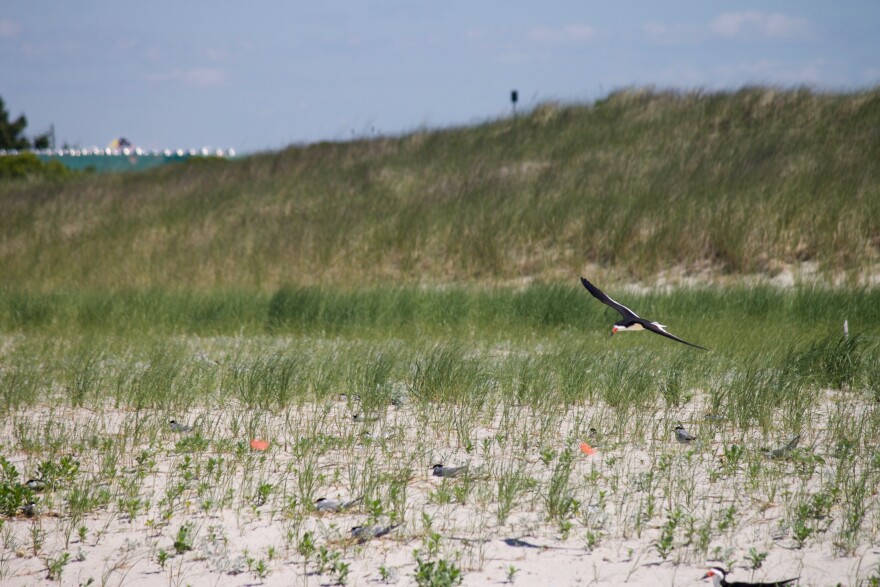If the longer days have you itching to get out in the garden, consider adding some native plants to your landscape design this year. Experts say that is the best way to support your local ecosystem and maintain biodiversity.
WSHU’s Sabrina Garone spoke with Maggie Muzante, lead nursery manager at the Long Island Native Plant Initiative in Brentwood, to learn more.
WSHU: Long Islanders, of course, we love a green lawn, right? But those sprawling landscapes, while they look super nice, they're not necessarily the best for the environment. Could you explain why that is?
MM: A lawn isn't great for the environment because it uses a lot of water. We'd rather be watering good plants that need establishing. It's also a monoculture, so there really aren't that many nutrients for pollinators and wildlife. It's pretty high maintenance, and whenever you have a lawn you need a lot of water, a lot of fertilizer, and a lot of things to keep it green. We need to gear towards gardens that are more healthy for the environment.
WSHU: And that's the mission of your organization, right? Could you give some background about how you guys got started and why you do what you do?
MM: We grow native plants of Long Island from seed. We grow ecotypic seeds on Long Island to really preserve those genetics. Sometimes native plants are grown in other states, you know, out west, and then sold on Long Island, calling them "Long Island native." And while the name of the species may be native here, it's not well adapted to our growing conditions.

WSHU: What makes Long Island's ecosystem unique compared to other parts of the state or even the whole country, and what areas need extra attention?
MM: Long Island was formed by glacial deposits creating a mix of sandy soil, rolling hills, and freshwater aquifers. So we have our wetlands, our Pine Barrens — we just had that large fire, Long Island Sound, and then our dunes. So native plants have a very long, long root system — anywhere between five and 20 feet deep. Meanwhile, the grass in your yard is probably five inches deep. The longer roots can absorb water better and hold together soil. I love this plant called Deer Tongue. I've seen it on a very dry clay cliff at Garvey's Point, and it was just, you know, holding the cliff together! Or I love seeing little bluestem and seaside goldenrods on the dunes, right at the beach. Usually, I go to Long Beach and Lido Beach, and I love seeing them there. They say, 'Don't walk on the dunes' because sand can move so quickly. So if you step on the sand, you know, it's going to fall down and just roll down that little hill. So it's really good to have those plants there to keep holding that sand together.
Which place needs the most help? Any place that has to do with water is at risk. That's where pollutants end up — in the water. We have rising sea levels, pollution, and coastal development threatens fish, shellfish, and migratory birds. The Great South Bay has a loss of eelgrass beds and shellfish. Oyster Bay and Cold Spring Harbor are doing oyster restoration and water quality improvements. We're also looking into better native aquatic plants to restore those areas where invasive plants are growing and overgrowths of algae.
WSHU: And pollinators are at risk right now, too. Could you speak to why it's so important that we cater to bees and butterflies?
MM: Pollinators pollinate the flowers that turn into fruits and prolong a plant's lifecycle. I've heard of apples and almonds in California being hand-pollinated by a person with a paintbrush! So, without natural pollinators, we'll suffer the consequences. We'll have to go out and pay people to pollinate plants — not the natural way — or we're going to have a lack of fruits and vegetables in our future.

WSHU: So for folks who want to contribute to Long Island's biodiversity in their own backyards, what are some easy ways to get started? What are some of your best tips that you can share?
MM: If you have a backyard, you can start by maybe killing your grass or ripping up any invasive plants that are taking up space. So if you want to smother your grass, you can do the cardboard method — you lay down cardboard or newspaper and some mulch on top, give it some time to solarize and kill the grass, or you can dig it up with a sod cutter or shovel. Start small and simple — you want to choose the right plants for the right location. You want to take into consideration the sunlight levels, how many hours of sunlight that area gets, and the drainage of your soil. And you just have to sit back and enjoy the process because it takes maybe two or three years for your garden to really take off. I always like the saying: sleep, creep and leap! The first year the plants are sleeping, they're kind of dormant, they're putting out their roots. And then the second year, the creeping happens, so the top of the plant, the stems, and the leaves are slowly getting bigger. Then the third year is the leap where the plants just completely take off, and then you're like — wow! These are really, really wild looking!
For more on Long Island's plants, animals and waterways, check out season one of WSHU's Higher Ground.


